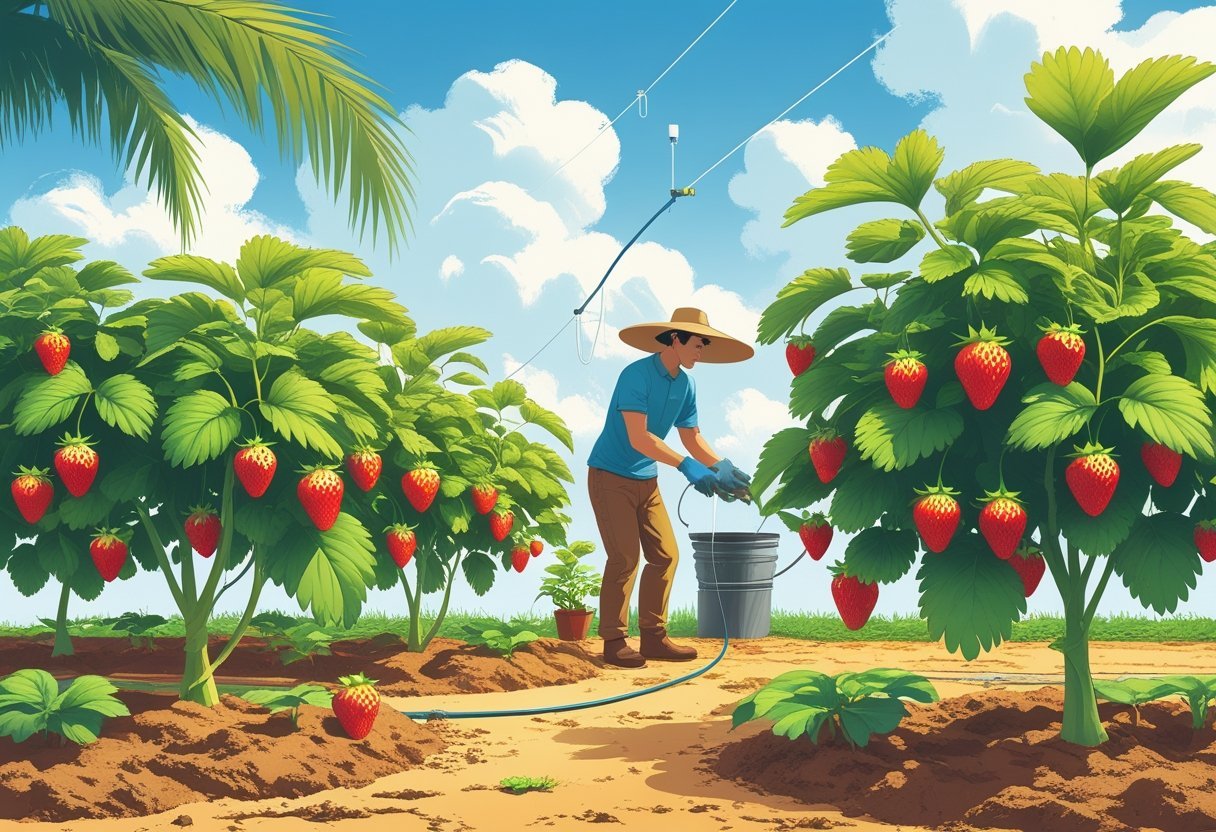Growing strawberries in Florida isn’t quite the same as in cooler states—you’ve got to work with the heat and that wild humidity. Best bet is to plant strawberries from late September through November, in soil that drains well and gets plenty of sun. Picking the right varieties like Camarosa, Chandler, or Festival? That can really make all the difference for your harvest.

Give your strawberry plants enough space—somewhere between 10 and 18 inches apart—so they can breathe and stretch out. They seem happiest with temps between 50 and 80 degrees Fahrenheit, and you’ll usually see fruit starting to ripen from late fall into early spring.
Key Takeaways
- Plant strawberries in fall, spaced out and in full sun.
- Go for varieties that actually like Florida’s climate.
- Keep an eye on temps and give regular care for healthy plants and fruit.
Best Practices for Growing Strawberries in Florida
If you want a decent strawberry harvest in Florida, you’ll need to nail the planting time, pick varieties that can take the heat, prep your soil, and use smart planting methods. Each of these really does matter.
Ideal Planting Times and Regional Differences
In Florida, aim to plant strawberries between late September and November. That’s when it cools down enough for the plants to settle in before things heat up again. Folks in north Florida might get away with planting a bit earlier, while central and southern gardeners should stick to October or November.
Harvest usually happens from February through March, which feels a little odd if you’re used to northern growing seasons. In the north, you may need to keep an eye out for frost and water more carefully at first.
Recommended Strawberry Varieties for Florida Gardens
Not every strawberry is cut out for Florida life. Camarosa, Chandler, Oso Grande, Sweet Charlie, and Selva are proven winners down here.
- Camarosa: Big berries, not too fussy, and pretty good at resisting disease.
- Chandler: Sweet, firm, and a favorite for central Florida.
- Oso Grande: Large fruit and solid yields.
- Sweet Charlie: Early to ripen, with a gentler flavor.
- Selva: Soft texture and cranks out a lot of berries.
Pick what works for your microclimate—don’t just grab whatever’s at the garden center.
Preparing the Planting Site and Soil
Strawberries like sandy loam with a pH between 5.5 and 6.5. Sun is non-negotiable—aim for 6 to 8 hours a day if you can swing it.
Get your soil tested first, so you’re not guessing about nutrients. Mixing in compost or other organic matter helps keep moisture in and roots happy. Raised beds or mounded rows are a lifesaver in Florida’s soggy months; they keep roots from drowning.
Planting Techniques: Transplants, Raised Beds, and Containers
Transplants from a good nursery are the way to go—less risk of disease. Raised beds are a favorite: they drain well, make weeding easier, and you can control the mulch. A typical Florida raised bed is about 8–12 inches tall and 12–18 inches wide.
No yard? No problem. Containers work fine, just use a quality potting mix and make sure water can drain out the bottom. Keep plants 12–18 inches apart, even in pots, so they don’t crowd each other.
Water them in well after planting, but don’t drown them. Mulch with pine straw or regular straw to lock in moisture and keep weeds down.
Care, Harvest, and Troubleshooting for Florida Strawberries
Strawberries in Florida need a bit of TLC to really thrive. If you want healthy plants and a good haul, you’ll have to stay on top of fertilizing, watering, pest patrol, and knowing when to pick.
Fertilization and Watering Guidelines
Florida strawberries do best with a balanced fertilizer—think 10-10-10—every 4 to 6 weeks during the season. Nitrogen helps the leaves, phosphorus is for roots, and potassium boosts fruit quality.
Keep the soil moist, not soggy. Drip irrigation is a lifesaver for keeping leaves dry and disease down. Aim for about an inch of water per week. Make sure your soil drains well, especially when the summer rains roll in.
Protecting Plants From Pests and Diseases
You’ll probably run into aphids, spider mites, or thrips sooner or later. Check your plants often, and if you spot trouble, hit them with insecticidal soap or neem oil before things get out of hand. Birds are another headache—netting is usually the best defense for ripening berries.
Florida’s humidity is a playground for fungal stuff like gray mold and powdery mildew. Space your plants out (10–18 inches is good), and clear out dead leaves or runners to keep air flowing. Sometimes, even with good habits, you might need to use a fungicide if things get ugly.
Harvest Timing and Post-Harvest Handling
Strawberries taste best when they’re picked fully red—if they’re still a bit pale, they’re not quite ready yet. Down here in Florida, you’ll want to check your plants every couple of days (every 2 to 4, give or take) so you don’t end up with mushy or rotting berries. If you’re growing Camarosa, Chandler, or Selva, they’re especially happy with frequent, gentle picking.
Once you’ve got your harvest, handle those berries with care—nobody likes bruised fruit. Get them into a cool spot as soon as you can; Florida heat really does them no favors. Don’t wash them before storing (tempting as it is), just give them a rinse right before you eat. That way, you’re less likely to end up with a fuzzy, moldy mess.




